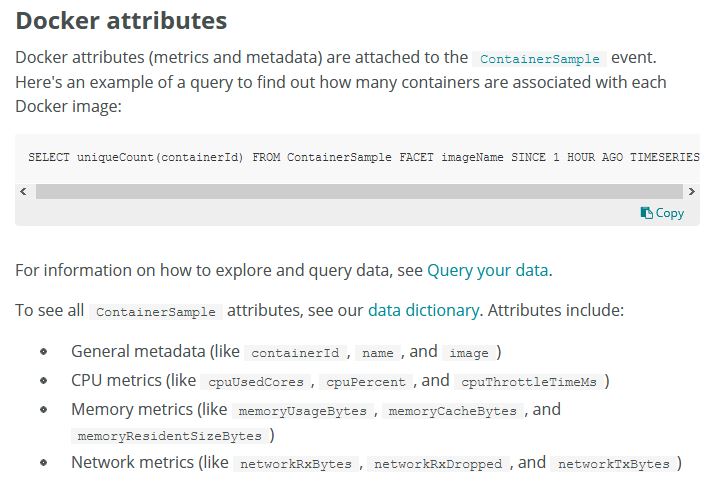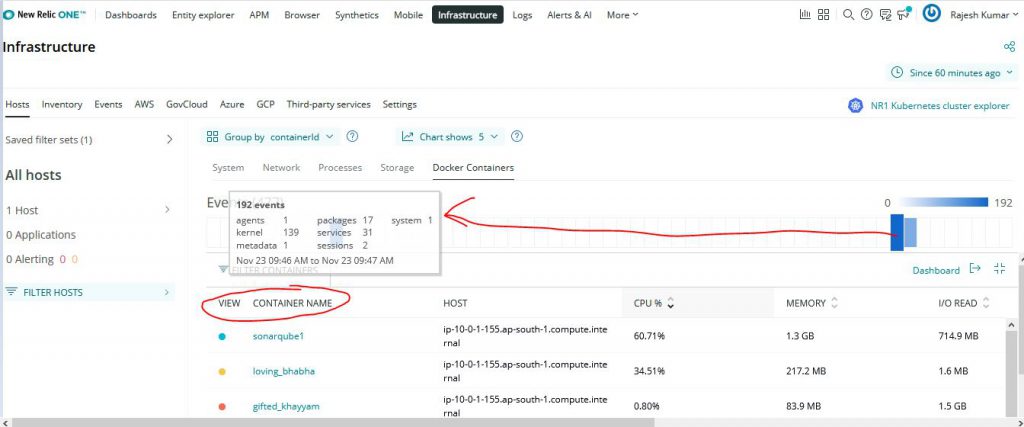Newrelic Infrastructure: Monitor Docker and Containers using Newrelic Infrastructure.
- Group containers by tags, attributes, and other metadata.
- Search for containers relevant to your monitoring scenario.
- Link to related entities that may be affected by issues with the container.
- Set Docker-related alert conditions.
Requirements & prerequisite
- Infrastructure agent 1.8.32 or higher running on Linux
- If using CentOS: must have CentOS version 6.0 or higher
- Docker version 1.12 or higher
How to Install, Enable and Start Docker Engine in Centos
Command 1 - Install required packages. yum-utils provides the yum-config-manager utility, and device-mapper-persistent-data and lvm2 are required by the devicemapper storage driver.
$ sudo -s
$ sudo yum install -y yum-utils device-mapper-persistent-data lvm2
Command 2 - Use the following command to set up the stable repository
$ sudo yum-config-manager --add-repo https://download.docker.com/linux/centos/docker-ce.repo
Command 3 - Install the latest version of Docker CE
$ sudo yum install –y https://dl.fedoraproject.org/pub/epel/epel-release-latest-7.noarch.rpm
$ sudo yum-config-manager --enable rhui-REGION-rhel-server-extras
$ sudo yum install -y docker-ce
$ sudo yum install docker-ce
Command 4 - Enable Docker
$ sudo systemctl enable docker
Command 5 - Start Docker and Verify Docker Installations
$ sudo systemctl start docker
$ docker -v
$ docker info
How to Install, Enable and Start Docker Engine in Ubuntu
How to Enable Docker container monitoring in Newrelic agent?
If you meet the requirements and have installed the correct infrastructure agent, there are no additional steps to enable Docker monitoring. If Docker is running, data will automatically be reported.
Enabled Process Monitoring in Newrelic Infra Agent & Restart Agent

You can view your Docker data in the Infrastructure monitoring UI in either of these ways:
- Go to one.newrelic.com > Infrastructure > Hosts > Containers. OR
- Go to one.newrelic.com > Infrastructure > Third-party services, and select Docker-related links.
Which are the Docker attributes reported by Newrelic?
Docker attributes (metrics and metadata) are attached to the “ContainerSample” event. Here’s an example of a query to find out how many containers are associated with each Docker image:
$ SELECT uniqueCount(containerId) FROM ContainerSample FACET imageName SINCE 1 HOUR AGO TIMESERIES

Sample Docker Commands to run Containers for monitoring?
$ docker run -d --name jenkins1 jenkins
$ docker run -itd --name ubuntu1 ubuntu
$ docker run -d --name sonarqube1 sonarqube
$ docker run -itd --name ubuntu2 ubuntu
$ docker run -itd --name ubuntu23 ubuntuNewRelic Docker Containers Events Data

I’m a DevOps/SRE/DevSecOps/Cloud Expert passionate about sharing knowledge and experiences. I am working at Cotocus. I blog tech insights at DevOps School, travel stories at Holiday Landmark, stock market tips at Stocks Mantra, health and fitness guidance at My Medic Plus, product reviews at I reviewed , and SEO strategies at Wizbrand.
Please find my social handles as below;
Rajesh Kumar Personal Website
Rajesh Kumar at YOUTUBE
Rajesh Kumar at INSTAGRAM
Rajesh Kumar at X
Rajesh Kumar at FACEBOOK
Rajesh Kumar at LINKEDIN
Rajesh Kumar at PINTEREST
Rajesh Kumar at QUORA
Rajesh Kumar at WIZBRAND

 Starting: 1st of Every Month
Starting: 1st of Every Month  +91 8409492687
+91 8409492687  Contact@DevOpsSchool.com
Contact@DevOpsSchool.com
 by
by 